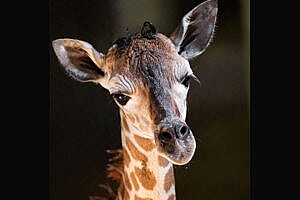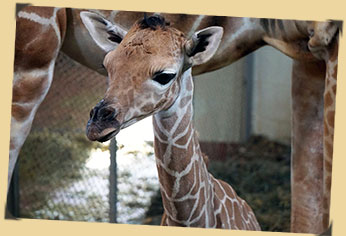Colorado Springs, CO – At the end of their conference-planning meeting last night, eight teenagers from Cheyenne Mountain Zoo’s Youth Leadership Action Board rewarded themselves with a quick visit to check on potential mom-to-be Luna, our 10-year-old Mexican gray wolf. They had no idea they would get the thrill of a lifetime to witness the birth of the Zoo’s first wolf pup litter in 20 years! The teens were able to identify two squirmy little pups around 8:30 p.m., and Luna’s labor produced more pups throughout the night and into this morning.
The births are not only incredibly exciting for the Zoo staff, who have been actively working to successfully breed the species for many years, but they are also highly significant for the future of the species. It is possible that these pups could go on to help repopulate the species in the wild.
For many years, the Zoo housed a bachelor pack of wolves, but within the past seven years, the Association of Zoos and Aquariums’ (AZA’s) Species Survival Plan (SSP) has placed various breeding pairs at Cheyenne Mountain Zoo with the hopes of offspring. Until now, none of the breeding pairs have been successful. Luna’s successful pregnancy is notable because she has very valuable and underrepresented genetics that the SSP was eager to have carried on in the captive population. When they are older, it is possible that Luna’s pups could be released to the wild to help provide genetic diversity in the wild, as well.
Luna is currently exhibiting great maternal behavior and is caring for the pups in a cozy underground den within the wolf exhibit. Staff members were able to monitor the births and Luna’s care of the litter through a camera mounted inside the den. The camera is connected to a monitor in the guest viewing area, so once the exhibit is reopened to the public tomorrow, everyone who visits the Zoo will be able to see footage of mom and babies at the exhibit. Video clips of mom and pups will also be shared on the Zoo’s YouTube and Facebook sites.
The sire for the litter is Navarro, who came to Cheyenne Mountain Zoo last November. The litter arrived just one day shy of Navarro’s birthday, giving him a wonderful early birthday gift! Navarro’s genetics are considered very valuable, also. Because Luna is showing quality maternal instincts, we have not intervened to determine the exact number or genders of the pups born.
The birth of this litter is significant because there are currently only 114 Mexican gray wolves in the wild, and only about 300 in human care. Until the 1900s, the Mexican gray wolf thrived throughout central Mexico, Arizona, New Mexico and western Texas. But by the 1950s, the species was virtually wiped out, with the last known wild wolf in the U.S. shot in 1970. When the Endangered Species Act went into effect in 1973, it led to the Mexican gray wolf being declared an endangered subspecies. Their number has since been increased through captive breeding programs.
The population of Mexican gray wolves in human care at Association of Zoos and Aquariums (AZA)-accredited zoos is an important part of the plan to repopulate the species in the wild. The Mexican Gray Wolf Recovery Program is run by U.S. Fish & Wildlife Service, with cooperation from the AZA Mexican Wolf Species Survival Plan. Cheyenne Mountain Zoo has been a participant in the program since 1994.
“We knew there was possibility that Luna, our 10-year-old female, was pregnant, but it is also fairly common for wolves to experience pseudo pregnancies,” said Dina Bredahl, animal care manager for Rocky Mountain Wild. “Pseudo pregnancies exhibit the same behavioral and physical changes in the mother, so we were cautiously optimistic that this was an actual pregnancy. The keepers and I are thrilled that she has given us pups!”
Imagery: https://www.dropbox.com/sh/d8216ofok19ksz3/AAB_B7-JmLPxg5vNU2gCwR0fa?dl=0
About Cheyenne Mountain Zoo
Cheyenne Mountain Zoological Society was founded in 1926. Today, Cheyenne Mountain Zoo, America’s ONLY mountain zoo, offers comprehensive education programs, exciting conservation efforts and truly fantastic animal experiences. It is Cheyenne Mountain Zoo’s hope that guests fall in love with animals and nature, and take action to protect them. Of the 230 zoos and aquariums accredited by the Association of Zoos and Aquariums (AZA), Cheyenne Mountain Zoo is one of just nine operating without tax support. Cheyenne Mountain Zoo depends on admissions, membership dues and donations for funding.


